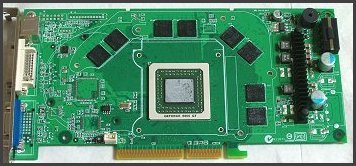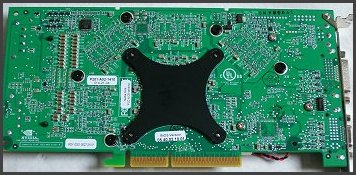Reference Boards Examined
Can you tell them apart? Me neither. You have to get under the skin of the single-slot cooler reference boards (or plug them into a system!) before you can tell them apart.
Doing that is simple. Unscrew a pair of screws on the fan shroud, on the top side of the board, then the three silver screws on the rear. Unplug the fan connector from the board, freeing that part of the assembly. That leaves you with the fan assembly free. The fan is a BFB0712H Delta blower, 38dBA, 2900rpm and it shifts 11.3 cubic feet per minute. Once that's done you can see the aluminium GPU and memory heatsinks.
Removing those heatsinks is simple. For the memory heatsink, unscrew the five black, spring-loaded screws on the back side of the board. The GPU heatsink is removed by the four silver screws, again spring-loaded, on the top side of the board.
Doing so to the 6800 GT gets you the following.
The GT gets Samsung's K4J55323QF GDDR3 2.0V DRAMs. Fabricated using the FBGA package type, the 32Mx8 devices are rated to 500MHz (1000MHz DDR).
The plain 6800 reference board gets Hynix HY5DU283222A DDR DRAMs, again using the FBGA package type (they look identical to the Samsung GDDR3 devices on the GT and Ultra) and are 2.5V devices. At 2.8ns, they're good for ~357MHz (~715MHz DDR).
Looking at the rear of the boards shows nothing new compared to the Ultra, bar the removal of the Ultra's Silicon Image 178CT64 TMDS, used for driving that board's second DVI port.
Ordinarily, the next few pages would be spent talking about the 6-series's GPU technologies, such as CineFX, Shader Model 3.0 and Intellisample, but since that's already been covered in the Ultra article, starting here, I'll just point you there if you're interested.
Straight onto the benchmarks.












